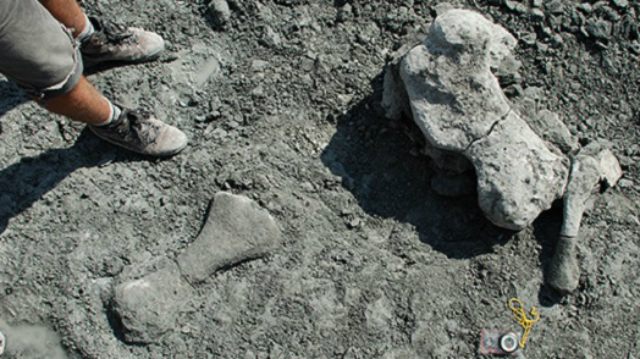Fossil of giant ‘mammal-like’ prehistoric reptile found in Poland
Experts say the previously unknown species may change our understanding of evolutionary history

The discovery of fossilised remains of an enormous prehistoric reptile in southern Poland has revealed that dinosaurs weren’t the only massive creatures roaming the planet 200 million years ago.
The fossil has been identified as a previously unknown variant of dicynodont, part of the therapsid group which are the ancestors of all modern mammals. The new species has been named Lisowicia bojani, after the German anatomist Ludwig Heinrich Bojanus and Lisowice, the village near the discovery site.
The animal has been described as a cousin to the mammal, and is thought to have been an heribove with smooth skin and no teeth, somewhat similar to a hippo in appearance, says New Scientist.
The Week
Escape your echo chamber. Get the facts behind the news, plus analysis from multiple perspectives.

Sign up for The Week's Free Newsletters
From our morning news briefing to a weekly Good News Newsletter, get the best of The Week delivered directly to your inbox.
From our morning news briefing to a weekly Good News Newsletter, get the best of The Week delivered directly to your inbox.
Its enormous size - standing as tall as an African elephant and weighing up to nine tonnes – could alter our understanding of evolutionary history, as scientists have previously thought dinosaurs were the only animals to reach this size during the Triassic period. Other dicynodonts discovered in the past have been no larger than a cow.
“It’s natural to want to know how dicynodonts became so large. It blows holes in many of our classic ideas of Triassic ‘mammal-like reptiles’,” said Dr Grzegorz Niedzweidzi, part of a team from Sweden’s Uppsala University who assisted the excavation.
In addition to being the largest known non-dinosaur tetrapod, or four-legged animal, from the Triassic period, “Lisowicia is the youngest dicynodont” yet discovered, he added.
Most dicynodonts, along with other mammals, are thought to have retreated during an extinction period before the emergence of dinosaurs, and the Polish fossil is the first substantial find linking dicynodonts to the Late Triassic period in Europe.
A free daily email with the biggest news stories of the day – and the best features from TheWeek.com
Dr Tomasz Sulej of the Polish Academy of Sciences told The Independent that the new species was “a once-in-a-lifetime discovery”.
More than 1,000 prehistoric find have been made in and around Lisowice, which is thought to have been a river deposit during the Late Triassic period.
-
 5 fairly vain cartoons about Vanity Fair’s interviews with Susie Wiles
5 fairly vain cartoons about Vanity Fair’s interviews with Susie WilesCartoon Artists take on demolition derby, alcoholic personality, and more
-
 Joanna Trollope: novelist who had a No. 1 bestseller with The Rector’s Wife
Joanna Trollope: novelist who had a No. 1 bestseller with The Rector’s WifeIn the Spotlight Trollope found fame with intelligent novels about the dramas and dilemmas of modern women
-
 Codeword: December 20, 2025
Codeword: December 20, 2025The daily codeword puzzle from The Week
-
 How Bulgaria’s government fell amid mass protests
How Bulgaria’s government fell amid mass protestsThe Explainer The country’s prime minister resigned as part of the fallout
-
 Femicide: Italy’s newest crime
Femicide: Italy’s newest crimeThe Explainer Landmark law to criminalise murder of a woman as an ‘act of hatred’ or ‘subjugation’ but critics say Italy is still deeply patriarchal
-
 Brazil’s Bolsonaro behind bars after appeals run out
Brazil’s Bolsonaro behind bars after appeals run outSpeed Read He will serve 27 years in prison
-
 Americans traveling abroad face renewed criticism in the Trump era
Americans traveling abroad face renewed criticism in the Trump eraThe Explainer Some of Trump’s behavior has Americans being questioned
-
 Nigeria confused by Trump invasion threat
Nigeria confused by Trump invasion threatSpeed Read Trump has claimed the country is persecuting Christians
-
 Sanae Takaichi: Japan’s Iron Lady set to be the country’s first woman prime minister
Sanae Takaichi: Japan’s Iron Lady set to be the country’s first woman prime ministerIn the Spotlight Takaichi is a member of Japan’s conservative, nationalist Liberal Democratic Party
-
 Russia is ‘helping China’ prepare for an invasion of Taiwan
Russia is ‘helping China’ prepare for an invasion of TaiwanIn the Spotlight Russia is reportedly allowing China access to military training
-
 Interpol arrests hundreds in Africa-wide sextortion crackdown
Interpol arrests hundreds in Africa-wide sextortion crackdownIN THE SPOTLIGHT A series of stings disrupts major cybercrime operations as law enforcement estimates millions in losses from schemes designed to prey on lonely users